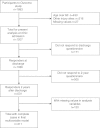Self perceptions as predictors for return to work 2 years after rehabilitation in orthopedic trauma inpatients
- PMID: 22562093
- PMCID: PMC3484271
- DOI: 10.1007/s10926-012-9369-x
Self perceptions as predictors for return to work 2 years after rehabilitation in orthopedic trauma inpatients
Abstract
Purpose: This study aimed to identify self-perception variables which may predict return to work (RTW) in orthopedic trauma patients 2 years after rehabilitation.
Methods: A prospective cohort investigated 1,207 orthopedic trauma inpatients, hospitalised in rehabilitation, clinics at admission, discharge, and 2 years after discharge. Information on potential predictors was obtained from self administered questionnaires. Multiple logistic regression models were applied.
Results: In the final model, a higher likelihood of RTW was predicted by: better general health and lower pain at admission; health and pain improvements during hospitalisation; lower impact of event (IES-R) avoidance behaviour score; higher IES-R hyperarousal score, higher SF-36 mental score and low perceived severity of the injury.
Conclusion: RTW is not only predicted by perceived health, pain and severity of the accident at the beginning of a rehabilitation program, but also by the changes in pain and health perceptions observed during hospitalisation.
Figures


Similar articles
-
The effect of recalled previous work environment on return to work after a rehabilitation program including vocational aspects for trauma patients.J Occup Rehabil. 2011 Mar;21(1):43-53. doi: 10.1007/s10926-010-9255-3. J Occup Rehabil. 2011. PMID: 20623164
-
Return to work expectations of workers on long-term non-work-related sick leave.J Occup Rehabil. 2012 Mar;22(1):15-26. doi: 10.1007/s10926-011-9313-5. J Occup Rehabil. 2012. PMID: 21701951
-
Prevalence and predictors of return to work in hospitalised trauma patients during the first year after discharge: a prospective cohort study.Injury. 2012 Sep;43(9):1606-13. doi: 10.1016/j.injury.2011.03.038. Epub 2011 Apr 13. Injury. 2012. PMID: 21489524
-
Health status, its perceptions, and effect on return to work and recurrent sick leave.Spine (Phila Pa 1976). 2005 May 1;30(9):1086-92. doi: 10.1097/01.brs.0000161484.89398.48. Spine (Phila Pa 1976). 2005. PMID: 15864164
-
Predictors for return to work after physical injury in China: A one-year review.Work. 2018;60(2):319-327. doi: 10.3233/WOR-182735. Work. 2018. PMID: 29865101 Review.
Cited by
-
Validation of the Readiness for Return-To-Work Scale in Outpatient Occupational Rehabilitation in Canada.J Occup Rehabil. 2018 Jun;28(2):332-345. doi: 10.1007/s10926-017-9721-2. J Occup Rehabil. 2018. PMID: 28756480
-
Assessing Psycho-social Barriers to Rehabilitation in Injured Workers with Chronic Musculoskeletal Pain: Development and Item Properties of the Yellow Flag Questionnaire (YFQ).J Occup Rehabil. 2018 Jun;28(2):365-376. doi: 10.1007/s10926-017-9728-8. J Occup Rehabil. 2018. PMID: 28887786
-
ICF-based prediction of return to work after trauma rehabilitation: Results of the icfPROreha study in patients with severe musculoskeletal injuries.Front Rehabil Sci. 2022 Sep 1;3:960473. doi: 10.3389/fresc.2022.960473. eCollection 2022. Front Rehabil Sci. 2022. PMID: 36189052 Free PMC article.
-
Cross-Cultural Adaptation of the Work Rehabilitation Questionnaire (WORQ) to French: A Valid and Reliable Instrument to Assess Work Functioning.J Occup Rehabil. 2019 Jun;29(2):350-360. doi: 10.1007/s10926-018-9795-5. J Occup Rehabil. 2019. PMID: 29946812
-
A Return-to-Work Prognostic Model for Orthopaedic Trauma Patients (WORRK) Updated for Use at 3, 12 and 24 Months.J Occup Rehabil. 2017 Dec;27(4):568-575. doi: 10.1007/s10926-016-9688-4. J Occup Rehabil. 2017. PMID: 28012065 Free PMC article.
References
-
- Schultz IZ, Crook J, Fraser K, Joy PW. Models of diagnosis and rehabilitation in musculoskeletal pain-related occupational disability. J Occup Rehabil. 2000;10(4):271–293. doi: 10.1023/A:1009484416267. - DOI
-
- Turk DC, Monarch ES. Biopsychosocial perspective on chronic pain. In: Turk DC, Gatchel RJ, editors. Psychological approaches to pain management. A practitioner’s handbook. 2. New York: Guilford; 2002.
MeSH terms
LinkOut - more resources
Full Text Sources
Medical

